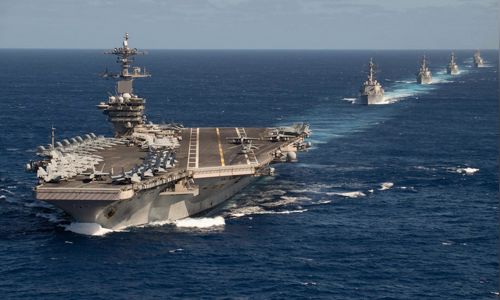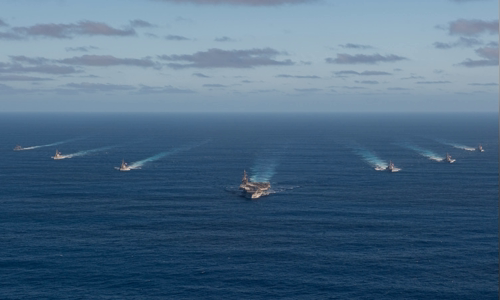The US aircraft carrier can prevail against Chinese warships thanks to long-range reconnaissance capabilities if a conflict breaks out, according to Russian expert Konstantin Sivkov.
The US Navy on February 12 announced a budget proposal for fiscal 2021, which ordered the purchase of 1,625 missiles of all types, of which more than half were long-range anti-ship weapons, 10 times more than the proposal. 5 years ago. This seems to be a countermeasure against China's naval capacity-building efforts in recent years.

US carrier group on the Pacific in January Photo: US Navy
China has recently built its military strength, especially the navy, at a significant pace to compete with the US in the Pacific. With the Chinese navy investing heavily in supersonic anti-ship weapons, many are concerned that American aircraft carriers will lose out to the power of these weapons if major battles at sea take place in China. future.
However, Konstantin Sivkov, an expert at the Russian Academy of Rocket and Artillery Sciences, predicts that if a confrontation between the two aircraft carriers broke out, the United States would surely gain an advantage.
"The core role that determines the outcome of naval battles today lies not in the strength and number of the weapons being attacked, but in the reconnaissance in combat space. The US Navy excels in the field of combat. this and could overwhelm the supersonic anti-ship missile of China, "Sivkov commented in an article in the Military Industry magazine of the Ministry of Defense of Russia in late 2019.
Sivkov points out that in the confrontation between the US and Japanese aircraft carriers during World War II, especially the Battle of Midway, the outcome of victory depends on which side discovered the enemy aircraft carrier earlier. The side that will detect the enemy will actively deploy air strikes from afar at the exposed target, putting the enemy in a passive position to support.
The United States owns the largest aircraft carrier force in the world, while China has only two aircraft carriers, including Liaoning and Shandong. Beijing is cherishing the ambition to build at least two more carriers to deploy power in the Western Pacific, even farther.
"China lacks the ability to deploy long-range power due to the lack of a network of bases abroad. A carrier war will break out around bases within 1,500 km from the Chinese coast or territory. a friendly country with Beijing in the Indian Ocean, "Sivkov said.
The weakness of the aircraft carrier's main force, the J-15 fighter force, is forcing Beijing to find warfare within the range of its land-based anti-ship missiles and land-based aircraft. The Chinese navy also relies on submarines, KJ-2000 early warning aircraft and satellites to locate the U.S. aircraft carrier combat group.
In contrast, US aircraft carriers can carry E-2C / D early warning aircraft and EA-18G electronic warplanes, in combination with early warning aircraft to take off from the allied base. Sivkov said the Chinese forces were only able to determine the relative position of the U.S. aircraft carrier, while the US aircraft carrier combat group could accurately detect the enemy's movement.
The Russian expert also proposed a hypothetical confrontation scenario between the two US and Chinese aircraft carrier combat groups. "In the early stages of the war, both sides suffered certain losses. China could damage one or two submarines, one surface ship, two or three reconnaissance aircraft and two to four fighters. About on the US side, the heaviest loss for them will be the loss of a submarine, one or two reconnaissance aircraft and four fighters, "Sivkov said.
In the next phase, Sivkov estimated that the Chinese aircraft carrier can only deploy about 6 attack fighters, the rest must be on defensive patrol duty. J-15s can launch anti-ship missiles to destroy or neutralize some destroyers outside the US carrier group. In contrast, the US aircraft carrier can deploy more than 30 fighters to attack the enemy.

A group of US aircraft carriers moved across the Pacific in January Photo: US Navy
"Simulation of the situation at this time shows that the Chinese carrier group has a favorable opportunity to attack but will lose up to 40-50% of the potential. A series of firing with dozens of YJ-18 anti-ship missiles has 20-30% chance to eliminate US aircraft carrier from the war. The effectiveness of counterattack of US fighter on Chinese aircraft carrier can reach 40-50% ", Sivkov said.
Severe damage will force Chinese forces to withdraw. Chinese carriers can be disabled, even sunk with 4-5 escorts, two submarines and more than half of the aircraft on board. Group of US ships will damage no more than 3 warships, 20% of the fleet. Particularly, the US aircraft carrier was only slightly damaged, even unharmed.
"In other words, the Chinese aircraft carrier group will be defeated and incapable of fighting. US forces will win without losing too much strength," Sivkov stated, asserting that this is a complex situation. However, there are many assumptions, as each party has only one carrier and does not use external support forces.
Russian experts believe that battles between aircraft carriers in the 21st century will be similar to the Pacific fronts during World War II, when aircraft taking off from the ground and submarines play a minor role, while the war actually takes place between air crews coming from aircraft carriers. "However, anti-ship ballistic missiles, bombers equipped with supersonic missiles and modern submarines can change this model," Sivkov said.



 HarshaMehrotra
HarshaMehrotra







